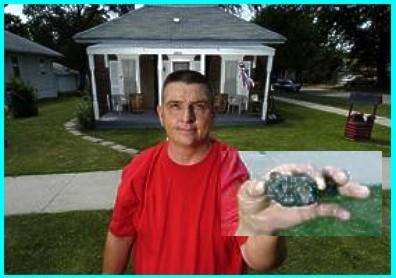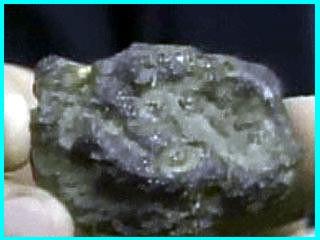
Expert: Object is no meteorite
By Jonnie Tate Finn
8-28-05
The Lincoln Journal Star
Brad Kinzie’s life was changed when something glowing and smoking whizzed over his head in the early morning hours of June 24. By Jonnie Tate Finn
8-28-05
The Lincoln Journal Star
The 50-year-old Fairbury man thought it was a meteorite. Others thought something just might have hit him in the head.
Local TV news crews and radio talk show hosts speculated on the object’s authenticity, while representatives from NASA and universities across the country called to confirm Kinzie’s story.
He stood by it.
“They made jokes about me on the radio,” Kinzie said. “But I didn’t care. What? They think someone just threw a burning rock at me in the middle of the night?”
Kinzie believed the meteorite theory so much he stored it in a safety deposit box at a Fairbury bank.
“I heard it could be worth thousands,” Kinzie said. “You only live once. That’s why I want to see if I can sell it, you know, after I get it tested at the university.”
So Kinzie scheduled an appointment to have the rock analyzed by a technician Thursday at the University of Nebraska-Lincoln. This was to be the object’s first test.
But after Kinzie drove the 70 miles from Fairbury, the small, porous object was not examined as he was told it would be.
Instead, UNL emeritus professor Sam Treves, who studies the structure, composition and classification of rocks, told Kinzie the technician who was to test the specimen was on another assignment.
But Treves prodded the object, examined it under a hand lens and concluded Kinzie’s sample was probably not a meteorite.
He showed Kinzie examples of genuine space rock.
“See,” said Treves, holding up the smooth, heavy form of an iron meteorite. “The external features on a meteorite are very distinctive, because they’re ablating as they enter Earth’s atmosphere and that creates that smooth surface.”
Treves said Kinzie’s object closely resembled volcanic rock because of its porous and glassy look. However, volcanic rock doesn’t drop from the sky and isn’t found naturally in a place like Fairbury.
“I can tell you where to get other opinions,” Treves told Kinzie, handing back the rock. “The fact that it was a fall and not a find is very important.
“One thing is for sure: It’s not an iron meteorite. I’m sorry.”

Treves said technicians would still analyze the specimen to see if it’s a stony meteorite. A sample will be cut from the rock and ground down to 30 microns — really thin. They will look for chondrules, which are grainlike structures embedded in some stony meteorites.
“I’m going to find out for sure if it is or isn’t,” a disappointed Kinzie said as he walked out of Morrill Hall. “It just has to be.”
More . . .
Home

No comments :
Post a Comment
Dear Reader/Contributor,
Your input is greatly appreciated, and coveted; however, blatant mis-use of this site's bandwidth will not be tolerated (e.g., SPAM, non-related links, etc).
Additionally, healthy debate is invited; however, ad hominem and or vitriolic attacks will not be published, nor will "anonymous" criticisms. Please keep your arguments/comments to the issues and subject matter of this article and present them with civility and proper decorum. -FW